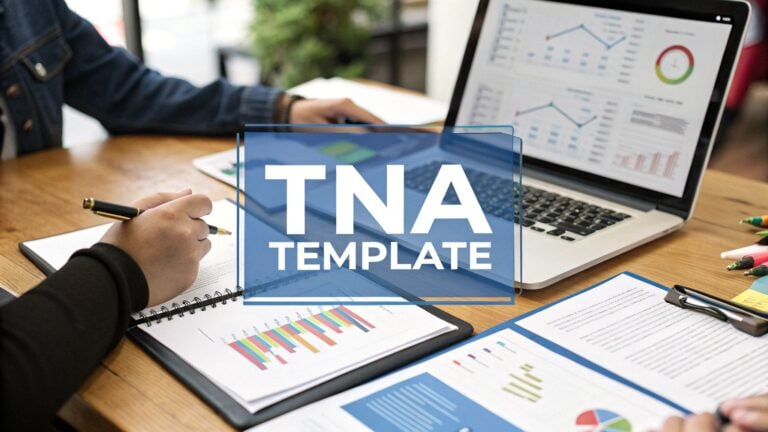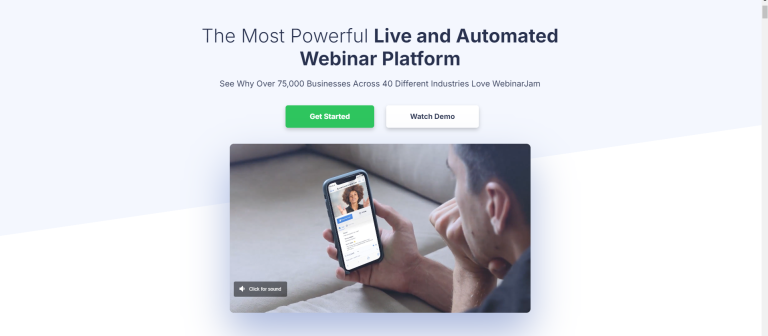7 Microlearning Best Practices That Actually Work

Welcome to LearnStream! I’m Jason Webber, and I’m always looking for ways to make online learning more effective and, let’s be honest, less of a chore.
If you’ve ever felt overwhelmed by a massive online course or struggled to keep learners engaged, you’ve come to the right place. We’re going to dive into microlearning, which is all about delivering powerful, bite-sized lessons that stick.
I’ve seen this approach completely change the game for course creators by meeting learners right where they are: on their phones, during a coffee break, or whenever they have a spare five minutes.
But just making things short isn’t enough. To get real results, you need a solid strategy grounded in proven methods. That’s why I’ve put together this comprehensive list of the top microlearning best practices you need to know. These aren’t just theories. They are actionable steps you can start using today to create learning experiences that are not only quick but also incredibly impactful.
This guide is for anyone creating online learning content, from instructional designers and corporate trainers to e-learning entrepreneurs. We’ll explore specific techniques for crafting focused, engaging, and accessible content. You’ll learn how to structure your modules, incorporate multimedia, provide effective feedback, and leverage technology to create personalized learning paths that truly resonate with your audience.
So, grab your coffee, and let’s get into how to master the art of microlearning.
1. Keep Learning Modules Under 5-10 Minutes
The cornerstone of effective microlearning is keeping it short. This foundational practice involves creating learning content designed to be completed in a single, short session, typically lasting between 5 and 10 minutes. This approach is deeply rooted in cognitive science. It acknowledges the natural limits of our attention spans and working memory. When we present information in small, digestible chunks, learners are more likely to absorb, retain, and apply it.
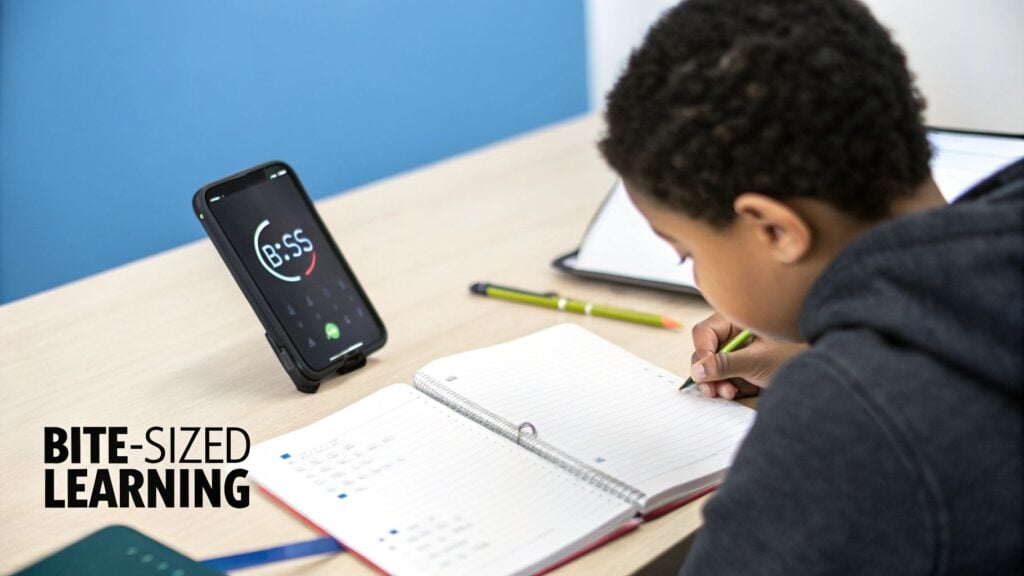
Pioneering work by figures like Hermann Ebbinghaus on the “forgetting curve” and Dr. Richard Mayer’s “cognitive load theory” highlights why this works. Shorter modules prevent cognitive overload. This is when the brain is asked to process too much information at once, leading to poor retention. By keeping lessons focused and brief, we align our training with how people naturally learn. This makes it one of the most critical microlearning best practices to implement.
Why It Works So Well
The beauty of the 5-10 minute module is its perfect fit into the modern professional’s schedule. A learner can complete a module while waiting for a meeting to start, during their commute, or on a short coffee break. This “just-in-time” learning accessibility empowers employees to seek out knowledge exactly when they need it, boosting both engagement and practical application.
Think of Duolingo’s language lessons. Their success is built on 5-minute sessions that feel more like a game than a chore. Similarly, platforms like LinkedIn Learning and Khan Academy break down complex topics into short, focused videos that are easy to consume and remember.
“If you can’t explain it in 10 minutes, you haven’t simplified it enough. Microlearning forces you to distill content down to its most essential, impactful core.”
Actionable Tips for Implementation
Keeping content this short requires a disciplined approach. The point is to deliver concentrated value, not just trim a longer video.
- One Goal, One Module: Dedicate each microlearning module to a single, specific learning objective. For example, instead of a module on “email marketing,” create separate modules for “writing effective subject lines” and “understanding open rates.”
- Time Yourself: When creating content, use a timer. If you’re consistently going over the 10-minute mark, it’s a sign that your topic is too broad and needs to be broken down further.
- Front-Load the Value: State the learning objective and key takeaway within the first 30 seconds. This immediately tells the learner what they will gain and why they should pay attention.
- Design for Interruption: Ensure your content can be easily paused and resumed. Modern learners are often multitasking, so your design should accommodate their reality.
2. Focus on Single Learning Objectives
While being brief is key, focus is its essential partner. This practice is all about designing each microlearning module around one single, measurable learning objective. This approach guarantees that learners can fully grasp one concept before they move on, instead of trying to cram multiple topics or skills into a short session. This laser-focus leads to significantly better comprehension, retention, and on-the-job application.
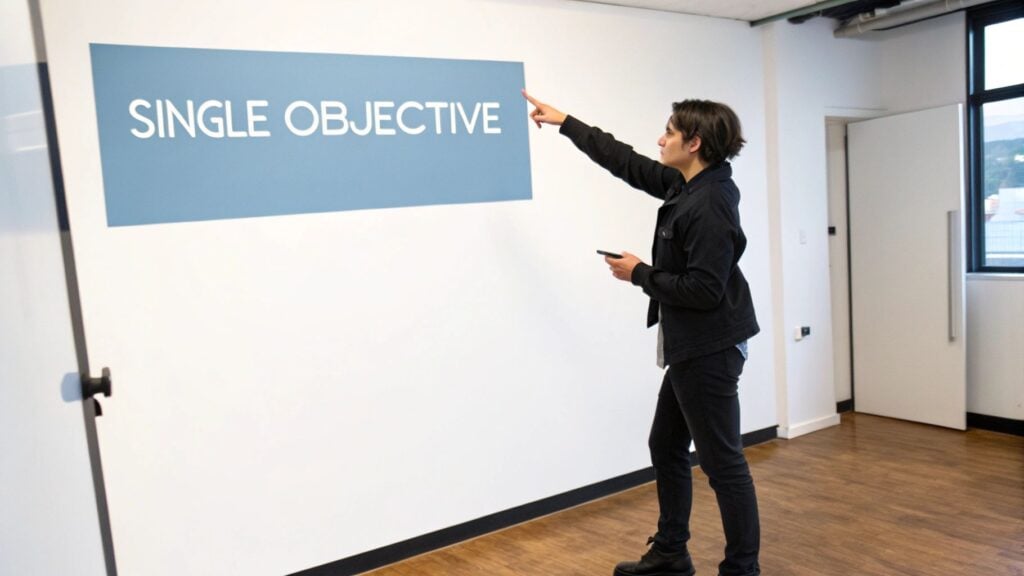
This idea isn’t new. It’s a core principle of effective instructional design, championed by theorists like Robert Mager and foundational to models like ADDIE. By isolating a single objective, we remove distractions and provide a clear, unambiguous path for the learner. This clarity is what makes microlearning so powerful and is a cornerstone of microlearning best practices. You give the learner a clear target, and every piece of content in the module helps them hit it.
Why It Works So Well
Focusing on a single objective per module drastically reduces cognitive load. The learner’s brain isn’t struggling to connect different ideas or figure out what’s most important. The goal is explicit and all content serves that one goal. This makes the learning process feel intuitive and efficient. This builds learner confidence and momentum, encouraging them to continue their training journey.
For instance, platforms like Axonify and Skillsoft’s Percipio excel at this. They deliver daily micro-lessons to frontline employees, with each one addressing a specific task or skill, like “how to properly handle a customer return” or “identifying the signs of a phishing email.” This objective-driven approach ensures training is always relevant and immediately applicable.
“A learning module without a single, clear objective is like a ship without a rudder. It might be moving, but it’s not heading toward a specific destination.”
Actionable Tips for Implementation
Defining a sharp, clear objective is the most critical step in creating focused micro-content. It’s the blueprint for everything that follows.
- Use Action Verbs: Start your objectives with strong action verbs that describe an observable behavior, inspired by Bloom’s Taxonomy. Use words like ‘Identify,’ ‘Demonstrate,’ ‘Calculate,’ or ‘Apply’ instead of vague terms like ‘Understand’ or ‘Learn.’
- Make it SMART: Ensure your learning objective is Specific, Measurable, Achievable, Relevant, and Time-bound. For example, “After this module, you will be able to identify the three key components of a persuasive email subject line.”
- Align Everything: Every video clip, piece of text, and quiz question must directly support and measure the achievement of that single objective. If it doesn’t, cut it.
- Consult the Experts: Run your learning objectives by subject matter experts (SMEs). They can confirm if the objective is accurate, relevant, and critical for the learner’s role. This is a vital step when you are first learning how to create an online course to sell.
3. Leverage Spaced Repetition and Just-in-Time Learning
Creating great microlearning involves more than just the initial delivery. You have to make the knowledge stick and ensure it’s available right when it’s needed most. This is where two powerful concepts, spaced repetition and just-in-time learning, come together. Spaced repetition involves re-exposing learners to content at increasing intervals to fight the forgetting curve. Just-in-time learning delivers information at the precise moment of need.
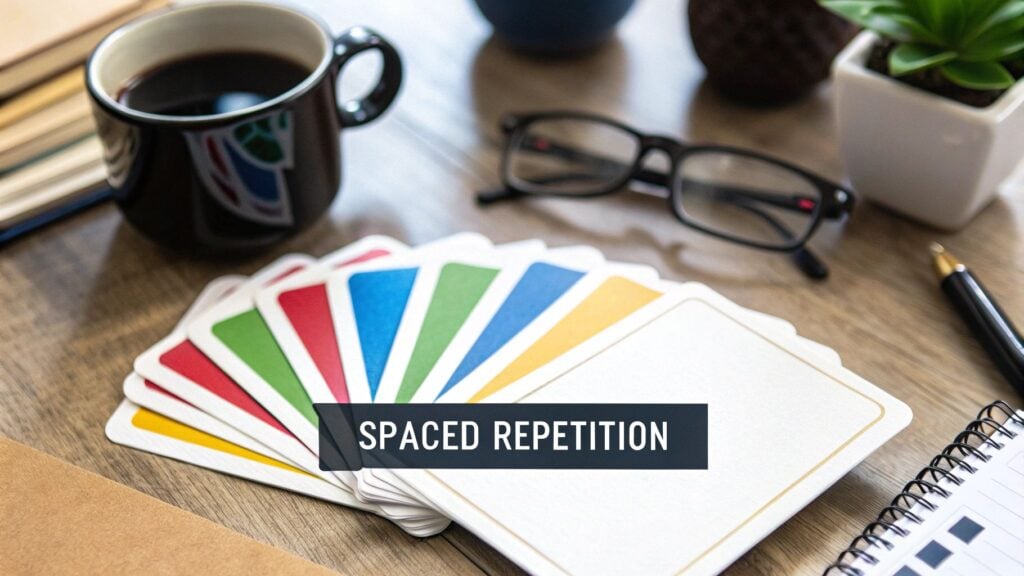
This dual approach turns learning from a one-time event into a continuous, reinforcing cycle. It’s a strategy pioneered by figures like Hermann Ebbinghaus, who first documented how our memories fade over time, and Gloria Gery, who championed performance support systems. Combining these ideas is one of the most effective microlearning best practices because it directly targets both long-term retention and immediate application. To truly embed the learning from micro-modules and optimize for long-term memory, exploring other powerful effective knowledge retention strategies can provide an even greater advantage.
Why It Works So Well
This strategy is incredibly effective because it aligns with our natural cognitive processes. Spaced repetition hacks our memory by reintroducing information just as we are about to forget it, strengthening the neural pathways. Just-in-time learning removes the friction between having a question and finding the answer, embedding the learning directly into the workflow.
A great example is the language-learning app Anki, which uses a sophisticated spaced repetition algorithm to help users memorize vocabulary. In a corporate setting, a platform like Axonify delivers daily micro-training to retail employees, reinforcing product knowledge and sales techniques right before their shifts start. This ensures the information is fresh and ready to use on the sales floor.
“The goal isn’t just to learn something once. It’s to recall it instantly when it matters. This combination of spaced reinforcement and on-demand access makes that possible.”
Actionable Tips for Implementation
Successfully merging these two concepts requires a thoughtful system that supports the learner’s journey over time.
- Integrate Learning into Workflow Tools: Don’t make learners go to a separate platform. Push reminders, quizzes, or short videos directly into tools they already use, like Slack, Microsoft Teams, or their email inbox.
- Use Analytics to Guide Spacing: Track learner performance on quizzes and assessments. Use this data to automatically adjust the timing of repetition intervals. If a learner struggles with a topic, present it to them more frequently.
- Create a Searchable Knowledge Base: For just-in-time support, all microlearning content should be easily searchable. A short video on “how to process a customer return” is useless if an employee can’t find it in seconds while standing at the register.
- Balance Automation with Control: While automated reminders are great, allow learners some control to “snooze” a review or request information on-demand. This respects their autonomy and varying workloads.
4. Design for Mobile-First Accessibility
In today’s world, learning happens everywhere, not just at a desk. This practice means creating microlearning content that works perfectly on a smartphone first and foremost. It also involves ensuring that everyone, including learners with disabilities, can access and use the content easily. Since most people reach for their phones to learn on the go, a mobile-first approach guarantees the best user experience while inclusive design opens the door for all learners.

This approach was heavily influenced by pioneers like Luke Wroblewski, who championed the “mobile-first” philosophy, and the Web Content Accessibility Guidelines (WCAG) from the W3C. The core idea is simple: if it works great on the small, constrained screen of a mobile device, it will scale up beautifully to larger screens. Combining this with accessibility makes your training not just convenient but truly universal. This is one of the most crucial microlearning best practices for modern organizations.
Why It Works So Well
Designing for mobile-first meets learners where they are. It respects their time and their habits, allowing them to engage with content during a commute, in between tasks, or whenever a free moment appears. This convenience dramatically increases engagement and completion rates. When you add accessibility, you expand your audience and create a more equitable learning environment.
Look at tools like Duolingo, which has built an empire on a mobile app that includes comprehensive accessibility features like screen reader support. Similarly, platforms like 7taps are designed specifically for creating mobile-native microlearning, proving how effective this focused approach can be. These examples show that a seamless, inclusive mobile experience isn’t a luxury, it’s a necessity.
“Designing for the smallest screen forces clarity and simplicity. Designing for accessibility ensures that clarity benefits every single learner, without exception.”
Actionable Tips for Implementation
Building for mobile and accessibility requires intention from the very start. It’s about more than just making sure your content fits on a small screen.
- Design with Your Thumb in Mind: Ensure all interactive elements like buttons and links are large enough to be easily tapped. A minimum size of 44×44 pixels is a great starting point to avoid frustration.
- Test on Real Devices: Don’t just rely on computer-based simulators. Test your content on a variety of actual smartphones and tablets to see how it truly performs in a real-world setting.
- Provide Captions and Transcripts: All video and audio content must have accurate, synchronized captions. This helps learners who are deaf or hard of hearing, as well as those learning in a noisy environment or without headphones.
- Use Accessibility Checkers: Incorporate tools like screen readers and automated accessibility checkers into your development process. This helps you catch and fix issues like poor color contrast or missing image descriptions early on.
5. Incorporate Interactive and Multimedia Elements
A purely text-based approach to learning can quickly become monotonous. This practice is all about enriching the learning experience by using diverse media formats and interactive components to capture and maintain learner attention. By weaving together text, images, short videos, audio clips, simulations, and quizzes, microlearning modules become far more engaging and effective. This multi-format strategy caters to different learning preferences, including visual, auditory, and kinesthetic styles, ensuring the content resonates more deeply.

The effectiveness of this approach is backed by well-established principles like Richard Mayer’s multimedia learning theory. This theory states that people learn better from words and pictures than from words alone. Using a variety of media helps reinforce key concepts and makes abstract ideas more concrete. This is one of the most impactful microlearning best practices because it transforms passive content consumption into an active learning experience, boosting both engagement and knowledge retention.
Why It Works So Well
Variety is key to keeping the modern learner engaged. Interactive and multimedia elements break the passive cycle of reading or watching, prompting the learner to think, click, drag, or respond. This active participation solidifies understanding and makes the learning process feel more dynamic and less like a chore.
Consider the success of TED-Ed’s lessons, which combine engaging animation with embedded questions to keep viewers actively involved. Similarly, tools like Kahoot! turn learning into a game, using friendly competition and instant feedback to reinforce knowledge. These examples show how multimedia isn’t just decoration. It’s a powerful tool for making learning stick. As you look to incorporate rich media, learning how to create effective explainer videos can be a powerful strategy for microlearning.
“Multimedia in learning isn’t about adding bells and whistles. It’s about choosing the right tool to build a bridge between the concept and the learner’s understanding.”
Actionable Tips for Implementation
Incorporating multimedia effectively requires a thoughtful, strategic approach. The goal is to enhance the learning, not distract from it.
- Match Media to the Message: Use the right format for the job. A short video is perfect for demonstrating a physical process, while an interactive simulation works well for decision-making skills. An audio clip might be best for language pronunciation.
- Keep It Purposeful: Every multimedia element should serve a clear learning purpose. Ask yourself, “Does this video or quiz help clarify the main objective?” If not, it might just be clutter.
- Optimize for Mobile: A huge benefit of microlearning is its accessibility on any device. Ensure your videos, images, and interactive elements are compressed and responsive, so they load quickly and function perfectly on a smartphone screen.
- Prompt for Interaction: Don’t let learners be passive for too long. Include a knowledge check, a drag-and-drop activity, or a simple poll every few minutes to re-engage their attention and test their comprehension.
6. Provide Immediate Feedback and Assessment
Learning is a conversation, not a lecture. A critical part of that conversation is immediate feedback, which involves giving learners instant responses to their actions and assessments. This is about leveraging a powerful psychological principle. Feedback is most effective when it’s delivered right at the moment of learning. This practice transforms passive content consumption into an active, responsive experience.
Theories from pioneers like B.F. Skinner on operant conditioning highlight how immediate reinforcement strengthens learning pathways. When learners know instantly whether they are on the right track, they can correct misconceptions in real time before they become ingrained habits. This prevents the frustration of moving forward with a flawed understanding and is one of the most impactful microlearning best practices for building learner confidence and competence.
Why It Works So Well
Immediate feedback closes the loop between action and understanding, creating a powerful learning cycle. It helps learners stay engaged and motivated because they can see their progress and understand their mistakes as they happen. This is very different from traditional training where a learner might wait days or weeks for a test result, by which time the context is lost.
Platforms like Codecademy master this by providing instant validation on every line of code a user writes. If there’s an error, a hint appears immediately. Similarly, Quizlet’s flashcard modes tell you right away if your answer is correct, reinforcing the right information while it’s still fresh in your mind. This interactive dialogue makes the learning process dynamic and far more effective.
“Feedback is the breakfast of champions. In microlearning, serving it instantly ensures learners are nourished and ready for the next bite of knowledge.”
Actionable Tips for Implementation
Delivering effective, instant feedback requires thoughtful design. It’s about guiding the learner, not just giving them a grade.
- Explain the ‘Why’: Don’t just show a “correct” or “incorrect” message. Provide brief, explanatory feedback that tells the learner why their answer was right or wrong. For example, “Correct! The ‘GROUP BY’ clause is used to aggregate data.”
- Offer Hints and Scaffolding: Before revealing the full solution, provide hints or links to relevant parts of the learning module. This encourages problem-solving instead of just memorization.
- Use Positive Framing: Frame your feedback constructively. Instead of “Wrong answer,” try something like, “Not quite, remember to check for X” or “Good try! Here’s a hint to get you closer.”
- Link to Remedial Resources: For incorrect answers on a key concept, include a direct link back to the specific micro-lesson or resource that covers that topic for a quick review. This is crucial for making your online course quizzes interactive and engaging.
7. Create Personalized Learning Paths
The one-size-fits-all model of training is quickly becoming obsolete. This practice involves tailoring the microlearning experience to individual learner needs, skill levels, and professional goals. Instead of pushing every learner down the same rigid path, personalization adapts the sequence, difficulty, and even the format of content. This creates a more relevant, engaging, and efficient learning journey that respects individual differences.
This approach leverages data and technology to deliver the right content to the right person at the right time. Research by pioneers like Peter Brusilovsky in adaptive hypermedia has shown that when learning adapts to the user, comprehension and retention improve significantly. This strategy is one of the most powerful microlearning best practices because it treats learners as individuals, not as a monolithic group, supercharging their motivation and results.
Why It Works So Well
Personalization transforms learning from a passive requirement into an active, empowering experience. Learners feel that their time is respected when they are not forced to review material they have already mastered or struggle with concepts presented too advanced for their current level. This targeted approach directly addresses individual skill gaps, accelerating proficiency and on-the-job application.
Platforms like Pluralsight excel at this by using adaptive skill tests to create custom learning paths that pinpoint exactly what a developer needs to learn next. Similarly, LinkedIn Learning suggests courses based on your job title, skills, and viewing history, making discovery both easy and relevant. We’re also seeing the benefit of technology in education as it allows for these sophisticated, data-driven learning models to scale.
“Personalization isn’t just a feature, it’s a fundamental shift in mindset. It’s about respecting the learner’s unique journey and providing the exact support they need to succeed.”
Actionable Tips for Implementation
Creating personalized paths requires a thoughtful, data-informed strategy. You don’t need complex AI to start, but you do need a plan.
- Start with an Assessment: Use a pre-course quiz or skills assessment to establish a baseline for each learner. This helps you understand their starting point and identify specific knowledge gaps.
- Tag Your Content: Meticulously tag each microlearning module with relevant skills, topics, and difficulty levels (e.g., beginner, intermediate, advanced). This metadata is the engine of personalization.
- Offer Learner Choice: Provide branching scenarios or let learners choose their own adventure. Ask them about their goals upfront and recommend a path, but give them the freedom to explore other topics.
- Use Learning Analytics: Track learner performance and engagement data. If many people are failing a certain module, it might be too difficult. If they are skipping another, it might be irrelevant. Use this feedback to continuously refine your paths.
Microlearning Best Practices Comparison
| Item | Implementation Complexity | Expected Outcomes | Ideal Use Cases | Key Advantages |
|---|---|---|---|---|
| Keep Learning Modules Under 5-10 Minutes | Low to moderate | Higher completion rates, better retention, less cognitive overload | Busy learners, mobile users, short attention spans | Fits into schedules, mobile-friendly, reduces overload |
| Focus on Single Learning Objectives | Moderate | Improved focus, measurable effectiveness, higher retention | Skill mastery, clear learning goals | Simplifies content, clearer expectations |
| Leverage Spaced Repetition and Just-in-Time Learning | High | Dramatically improved long-term retention, immediate application | Knowledge retention, on-the-job learning | Personalized pacing, efficient reviews |
| Design for Mobile-First Accessibility | Moderate to high | Anywhere, anytime learning, higher engagement, inclusivity | Mobile-centric learners, diverse audiences | Supports disabilities, complies with standards |
| Incorporate Interactive and Multimedia Elements | High | Higher engagement, appeals to learning styles, better retention | Engaging content, varied learner preferences | Multi-sensory learning, increased motivation |
| Provide Immediate Feedback and Assessment | Moderate to high | Prevents errors, maintains motivation, data for analytics | Self-paced learning, skill checks | Instant understanding, reduces instructor load |
| Create Personalized Learning Paths | High | Higher engagement, efficient learning, targeted skill growth | Adaptive learning, diverse learner needs | Tailored experience, increased autonomy |
Your Next Steps in Mastering Microlearning
We’ve just walked through seven powerful microlearning best practices, from keeping modules under ten minutes to building personalized learning paths. It’s a lot to take in, but the core idea is simple. Effective microlearning respects the learner. It delivers focused, relevant knowledge right when it’s needed, in a format that fits seamlessly into a busy day.
The real magic of microlearning is about being more intentional with every single learning asset you create. It means designing with a clear purpose, a specific outcome, and the end user’s experience in mind. When you nail these principles, you move from simply distributing information to creating genuine moments of learning and skill development. That’s the difference between content that gets ignored and content that gets results.
This approach transforms the learning landscape. For your learners, it means less frustration and more engagement. They can quickly find answers, solve problems, and build skills without disrupting their workflow. For you, it means higher completion rates, better knowledge retention, and a more agile, adaptable training program.
From Theory to Action: Your Implementation Roadmap
I know that seeing a list of best practices can feel overwhelming. You don’t need to tackle all seven at once. The key is to start small, build momentum, and iterate as you go. Think of it as applying microlearning to your own professional development.
Here’s a simple, actionable plan to get you started:
Pick Your Starting Point: Look back at the seven practices we covered. Which one feels most achievable or addresses your biggest current challenge? Maybe it’s tightening your modules to focus on single learning objectives. Or perhaps you’re ready to make your content shine on mobile devices. Choose just one or two to focus on first.
Audit a Single Module: Select one of your existing learning modules or lessons. Put on your “microlearning” hat and analyze it against the best practices you chose. Is it too long? Does it try to cover too many topics? Is there an opportunity to add a quick interactive quiz or a short video?
Create a Pilot Project: Rework that single module using your chosen principles. Don’t aim for perfection. Aim for progress. This pilot will be your testing ground. For example, you could turn a 30 minute video into three separate 5 minute videos, each with a clear takeaway and a one question quiz.
Gather Feedback and Measure: Deploy your new micro-module to a small group of learners. Ask for their direct feedback. Did they find it more engaging? Was it easier to complete? Also, look at the data. Did completion rates improve? Were assessment scores higher? Use this information to refine your approach.
Expand and Scale: Once you’ve seen positive results from your pilot, you can start applying these microlearning best practices more broadly. Use what you learned to create a template or a checklist for all new content development. This ensures consistency and helps scale your efforts across your entire curriculum.
The Future is Small and Mighty
Adopting these microlearning best practices is more than just a trend. It’s a strategic shift toward a more effective, learner centric model of education and training. By delivering knowledge in small, targeted, and engaging bursts, you empower your audience to learn continuously and apply new skills with confidence.
You have the framework. Now, the next step is yours. The journey to mastering microlearning begins with a single, intentional action. So, which practice will you try first? Start there, and watch how these small changes create a big impact on your learning experiences.

